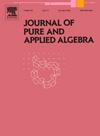On the conjugacy separability of ordinary and generalized Baumslag–Solitar groups
IF 0.7
2区 数学
Q2 MATHEMATICS
引用次数: 0
Abstract
Let be a class of groups. A group X is said to be residually a -group (conjugacy -separable) if, for any elements that are not equal (not conjugate in X), there exists a homomorphism σ of X onto a group from such that the elements xσ and yσ are still not equal (respectively, not conjugate in Xσ). A generalized Baumslag–Solitar group or GBS-group is the fundamental group of a finite connected graph of groups whose vertex and edge groups are all infinite cyclic. An ordinary Baumslag–Solitar group is the GBS-group that corresponds to a graph containing only one vertex and one loop. Suppose that the class consists of periodic groups and is closed under taking subgroups and unrestricted wreath products. We prove that a non-solvable GBS-group is conjugacy -separable if and only if it is residually a -group. We also find a criterion for a solvable GBS-group to be conjugacy -separable. As a corollary, we prove that an arbitrary GBS-group is conjugacy (finite) separable if and only if it is residually finite.
关于普通和广义baumslag -孤群的共轭可分性
设C是一类群。如果对于任意不相等(在X中不共轭)的元素X,y∈X,存在X到C的群上的同态σ使得元素xσ和yσ仍然不相等(分别在xσ中不共轭),则群X是残馀C群(共轭C可分)。广义Baumslag-Solitar群或gbs群是顶点群和边群都是无限循环的群的有限连通图的基本群。一个普通的Baumslag-Solitar群是对应于一个只包含一个顶点和一个环路的图的gbs群。假设C类是由周期群组成的,并且在取子群和无限制环积下是封闭的。证明一个不可解的gbs群是共轭c可分的当且仅当它是残馀c群。我们还发现了一个可解gbs群是共轭c可分的判据。作为一个推论,我们证明了任意gbs群是共轭(有限)可分的当且仅当它是剩余有限的。
本文章由计算机程序翻译,如有差异,请以英文原文为准。
求助全文
约1分钟内获得全文
求助全文
来源期刊
CiteScore
1.70
自引率
12.50%
发文量
225
审稿时长
17 days
期刊介绍:
The Journal of Pure and Applied Algebra concentrates on that part of algebra likely to be of general mathematical interest: algebraic results with immediate applications, and the development of algebraic theories of sufficiently general relevance to allow for future applications.

 求助内容:
求助内容: 应助结果提醒方式:
应助结果提醒方式:


